ViewSonic VP2772 27-Inch QHD Professional Monitor Review
Today we’re testing the latest addition to ViewSonic's professional monitor line, the VP2772. This 27-inch screen offers QHD resolution; Adobe RGB and sRGB color gamuts; and 10-bit color with a 14-bit LUT. We see if its performance and specs match up.
Results: Brightness And Contrast
Uncalibrated
Before calibrating any panel, we measure zero- and 100-percent signals at both ends of the brightness control range. This shows us how contrast is affected at the extremes of a monitor's luminance capability. We do not increase the contrast control past the clipping point. While doing this would increase a monitor’s light output, the brightest signal levels would not be visible, resulting in crushed highlight detail. Our numbers show the maximum light level possible with no clipping of the signal.
Our comparison group is the last six monitors reviewed at Tom’s Hardware.

A 265.9127 cd/m2 result is far enough below ViewSonic’s spec of 350 cd/m2 that we went back and redid the max luminance measurements. The published number is indeed the highest we could attain in the Adobe RGB mode with the backlight set to 100. There is a little more light available in the Native mode (282.348 cd/m2), but gamma tracking and color are less accurate. Since you'd likely want the VP2772 for its correct Adobe RGB gamut, we’ll stick to that for all the luminance tests. Fortunately, there is still enough light for a majority of viewing environments.
The black level is right in the middle of the pack.
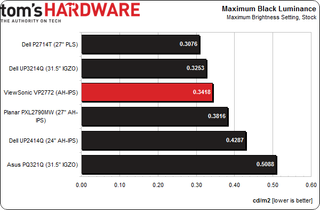
Considering that we're dealing with an IPS-based monitor, the black level result is reasonable. It’s helped by the fact that the max white level is lower than other screens. A reduced white level brings the max contrast number down a bit, too.
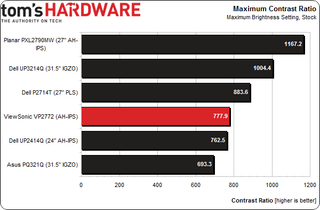
This is an average figure not only for this group, but for all of the screens we’ve tested in the past year. The best displays exceed 1000 to 1. As we move forward in the tests, we’ll be looking for consistency in contrast at all brightness levels.
We believe 50 cd/m2 is a practical minimum standard for screen brightness. Any lower and you risk eyestrain and fatigue. Some monitors, like the VP2772, measure under that level. We recorded a minimum white level of 39.1023 cd/m2 with the backlight turned all the way down. That's a bit too dim for practical use. Raising the brightness setting to four gets you 50 cd/m2.
Stay on the Cutting Edge
Join the experts who read Tom's Hardware for the inside track on enthusiast PC tech news — and have for over 25 years. We'll send breaking news and in-depth reviews of CPUs, GPUs, AI, maker hardware and more straight to your inbox.

Again, the black level is right in the middle of our group, nearly tied with a couple of Dell displays. If you increase the max brightness to 50 cd/m2, it still reads a low .0647 cd/m2. You can achieve extremely low black levels with the dynamic contrast feature, but then you give up detail at the dark end of the scale.
Are you ready for the contrast values?
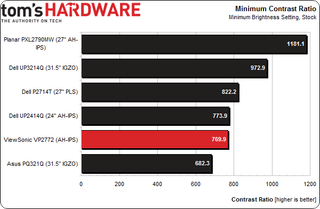
A result of 769.9 to 1 is just what we’re looking for given the maximum number. While there are displays that offer better contrast, not all of them are as consistent. We're seeing this in more of the newest screens, and the trend pleases us. Just a year ago, most monitors we measured had a definite sweet spot where contrast and other performance metrics were at their best. Now, the VP2772 and a few others deliver their full potential at all brightness levels.
After Calibration
Since we consider 200 cd/m2 to be an ideal point for peak output, we calibrate all of our test monitors to that value. In a room with some ambient light (like an office), this brightness level provides a sharp, punchy image with maximum detail and minimum eye fatigue. It's also the sweet spot for gamma and grayscale tracking, which we'll look at on the next page. In a darkened room, many professionals prefer a 120 cd/m2 calibration. Whichever your preference, it makes little to no difference on the calibrated black level and contrast measurements.

The VP2772 is still right there with the UP2414Q after calibration to 200 cd/m2. You can see all of the screens in the group are quite close together in a range of less than .0856 cd/m2. If you line them all up next to each other, you’d have a hard time telling any difference using just your eyes. As far as black levels go, these screens would all satisfy most folks.
And the following are our final calibrated contrast numbers.
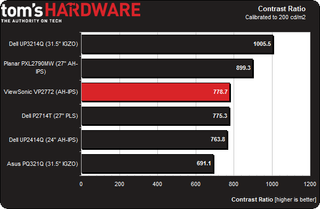
The VP2772’s consistency persists with a calibrated contrast ratio of 778.7 to 1. Out of our last 21 computer monitors tested, this one places thirteenth, which is frankly a below-average result. If you’re looking for high contrast, there are alternatives (though they might not be as consistent). Your best bet is to settle on a maximum output number and see if the screen you’re considering has good contrast at that level.
ANSI Contrast Ratio
Another important measure of contrast is ANSI. To perform this test, a checkerboard pattern of sixteen zero- and 100-percent squares is measured, yielding a somewhat more real-world result than on/off measurements that tests a display’s ability to simultaneously maintain both low black and full white levels, factoring in screen uniformity as well. The average of the eight full-white measurements is divided by the average of the eight full-black measurements to arrive at the ANSI result.
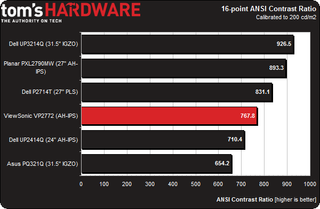
ViewSonic's ANSI result is only a tiny bit lower than the on/off outcome, denoting excellent performance. A monitor selling for more than a grand should be built from quality parts, and the VP2772 definitely is. A properly-made grid polarizer translates to no appreciable light leakage between the darkest and lightest parts of the image.
Current page: Results: Brightness And Contrast
Prev Page Measurement And Calibration Methodology: How We Test Next Page Results: Grayscale Tracking And Gamma Response
Christian Eberle is a Contributing Editor for Tom's Hardware US. He's a veteran reviewer of A/V equipment, specializing in monitors. Christian began his obsession with tech when he built his first PC in 1991, a 286 running DOS 3.0 at a blazing 12MHz. In 2006, he undertook training from the Imaging Science Foundation in video calibration and testing and thus started a passion for precise imaging that persists to this day. He is also a professional musician with a degree from the New England Conservatory as a classical bassoonist which he used to good effect as a performer with the West Point Army Band from 1987 to 2013. He enjoys watching movies and listening to high-end audio in his custom-built home theater and can be seen riding trails near his home on a race-ready ICE VTX recumbent trike. Christian enjoys the endless summer in Florida where he lives with his wife and Chihuahua and plays with orchestras around the state.
Most Popular

